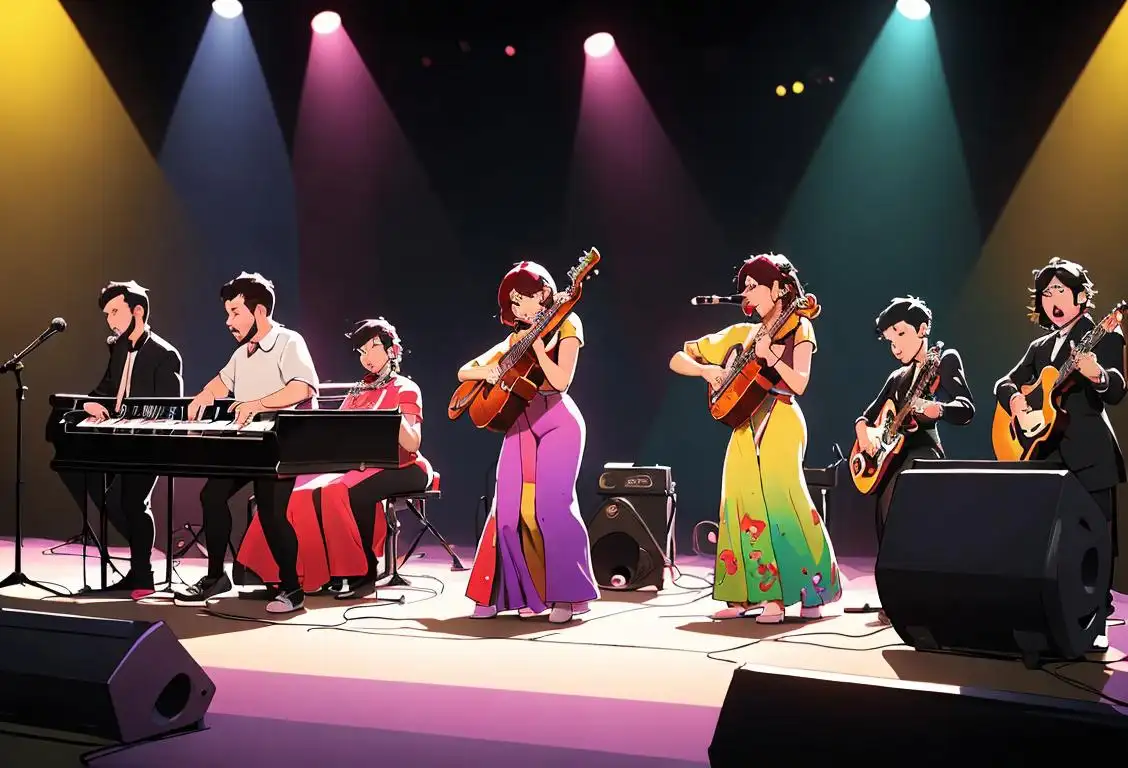National Bassist Day

Attention all music lovers! Get those fingers grooving and those feet tapping because it's National Bassist Day! Time to celebrate those unsung heroes of the rhythm section who lay down the low end and keep the groove going. Whether you're a die-hard fan of rock, jazz, or funk, we can all agree that a great bassist can make or break a band. So let's dive into the deep end and explore the history and significance of National Bassist Day!
When is Bassist Day?
It's national bassist day on the 7th November.
The Birth of National Bassist Day
While the exact origins of National Bassist Day are a bit murky, it gained popularity in recent years thanks to the power of the internet and the social media age. Bassists, who have long been overshadowed by guitarists and drummers, finally found their moment in the spotlight. And boy, did they deserve it!
On National Bassist Day, bass players from all over the world gather to celebrate their instrument of choice and showcase their incredible skills. From intricate fingerpicking to thumping slap bass solos, these musicians know how to make their presence felt.
Whether you're a bassist yourself or simply a fan of the deep, resonating sound, National Bassist Day is a time to appreciate the artistry and talent that goes into playing the bass guitar.
How to Celebrate
There are many ways to celebrate National Bassist Day and show your love for the bass. Here are a few suggestions:
- Attend a live concert or gig featuring a talented bassist.
- Create a playlist of your favorite bass-heavy songs and share it with your friends.
- Learn to play the bass yourself or dust off that old instrument and jam with fellow bass enthusiasts.
- Support your local music scene by attending shows and showcasing the bassists in your community.
No matter how you choose to celebrate, the important thing is to spread the love and appreciation for these often unsung heroes of the music world. Let the bassline guide your day and embrace the groovy vibes!
History behind the term 'Bassist'
1951
The Birth of the Bass Guitar
In 1951, Leo Fender introduced the first mass-produced electric bass guitar, the Fender Precision Bass. This innovation marked a significant shift in popular music, as it provided a lower-pitched alternative to the upright bass which was difficult to amplify. The introduction of the bass guitar laid the foundation for the emergence of bassists as a distinct role in the band.
1700s
The Emergence of the Double Bass
In the 1700s, the need for a larger and deeper-toned string instrument led to the creation of the double bass. This instrument, also known as the contrabass or bass viol, featured a lower range than the existing violin family of instruments. It initially had three strings and was primarily used in orchestras and chamber ensembles.
1500s
Inception of the Lute
In the 1500s, the lute, a fretted string instrument, gained popularity in Europe. The lute had a rounded body and a long neck with multiple strings. Musicians who played the lute would often pluck the strings with their fingers or use a small plectrum. This instrument laid the foundation for future bass-related terms.
1889
Birth of the Electric Bass
In 1889, Paul Tutmarc Sr., an American musician and inventor, created the first version of the electric bass. He called it the 'Electro Bass Fiddle.' It featured a solid body and was played horizontally like a cello. However, it did not gain much popularity at the time.
1700s
The Rise of the Double Bass
During the 1700s, orchestras started to enhance their sound by introducing larger and deeper sounding instruments. The double bass, also known as the contrabass, emerged as the cornerstone of the orchestra's low-end section. It featured a massive body, long neck, and four thick strings that were usually played with a bow. This instrument became a crucial part of the classical ensemble and marked a significant development in bass-related terms.
1935
The Birth of the Term 'Bassist'
It wasn't until 1935 that the term 'bassist' started to gain recognition. As the popularity of the electric bass began to grow in jazz and orchestral settings, individuals who played this instrument needed a distinctive title. The term 'bassist' emerged, referring to those who specialized in playing the bass.
1800s
The Evolution of the Double Bassist
During the 1800s, with the increased popularity of orchestral music, the role of the double bass started to expand. Composers began to write more complex and independent bass parts, requiring skilled musicians dedicated to playing the instrument. As a result, the term 'bassist' emerged to describe those who specialized in playing the double bass.
1960
The Rise of the Bassist
During the 1960s, as popular music genres such as rock and roll, rhythm and blues, and funk gained momentum, the role of the bassist became more prominent in bands. Bass lines became an integral part of the songs, providing the rhythmic and harmonic foundation. Bassists such as James Jamerson (Motown Records) and Paul McCartney (The Beatles) showcased the versatility and expressive potential of the instrument, further solidifying the importance of the bassist in popular music.
1920s
The Birth of Jazz
In the 1920s, jazz took the music scene by storm. This genre emphasized improvisation, syncopated rhythms, and intricate bass lines. As jazz ensembles grew in popularity, the need for a dedicated bass player became evident. Bassists provided the foundation for the jazz band, establishing the harmonic structure and supporting the rhythm section. This era introduced the term 'bassist' to describe these talented musicians.
1920s
Jazz Brings Recognition to Bass Players
In the 1920s, jazz music gained immense popularity, and the double bass played a crucial role in the rhythm section. Jazz bassists, known for their improvisational skills, brought the instrument into the spotlight. Notable jazz bassists like Jimmy Blanton and Walter Page showcased the bass's melodic capabilities and contributed to the development of bass technique and style.
1951
The Precision Bass Revolutionizes Music
In 1951, Leo Fender introduced the Fender Precision Bass, commonly known as the P-Bass. This instrument played a crucial role in shaping the sound of popular music genres like rock and roll, funk, and soul. The availability of a more affordable and versatile electric bass led to an increase in the number of bassists and further solidified the term's usage.
1970
The Evolution of Bass Playing Techniques
In the 1970s, bass playing techniques continued to evolve, with musicians pushing the boundaries of what the instrument could do. Bassists like Jaco Pastorius introduced fretless bass guitars, which allowed for smoother glissandos and increased tonal expressiveness. Additionally, funk and disco genres popularized techniques such as slap bass, pioneered by Larry Graham and later popularized by players like Mark King of Level 42.
1985
The Recognition of the Bassist
In 1985, the Rock and Roll Hall of Fame began inducting bassists specifically, acknowledging their contributions to the music industry. This recognition not only elevated the status of individual bassists but also highlighted the significance of the bassist's role in the overall sound and success of a band. Since then, many influential bassists have been honored, helping to cement the bassist as a recognized and celebrated musician.
1960
Bassist as a Recognized Role
By the 1960s, the term 'bassist' had firmly established itself as the recognized title for players of the bass guitar. As bassists took on more prominent roles within bands, contributing to complex melodies and becoming influential in shaping musical arrangements, their importance and identity as individual musicians became more pronounced.
1950s
The Rise of the Electric Bass Guitar
The invention of the electric bass guitar in the 1950s revolutionized the role of the bassist. Developed by Leo Fender and introduced by Fender Musical Instruments Corporation in 1951, the electric bass guitar offered a lighter, more portable alternative to the double bass. This innovation allowed bassists greater freedom of movement on stage and provided a distinct sound that shaped various music genres, including rock, funk, and R&B.
1960s
The Electric Bass Guitar Revolution
In the 1960s, a revolutionary instrument known as the electric bass guitar burst onto the music scene. This instrument took inspiration from the traditional double bass but featured a solid body, frets, and was played with the hands or a pick. The electric bass guitar provided greater projection, allowed for more diverse playing techniques, and greatly influenced popular music genres such as rock, funk, and disco. The term 'bassist' expanded its reach to include players of this new instrument.
Present Day
Bassists Across Genres
In modern times, 'bassist' has become a widely recognized term used to describe musicians who specialize in playing bass instruments, including the double bass, electric bass guitar, and other variations. Bassists contribute to a vast array of musical genres and styles, serving as the backbone of many bands and orchestras. Their skillful playing adds depth, rhythm, and groove to music, ensuring that they remain an essential part of the music world.
1970s
Bassists in the Spotlight
In the 1970s, with the rise of funk, disco, and jazz fusion, bassists began to shine in solo performances and as featured performers. Legendary bassists like Jaco Pastorius, Stanley Clarke, and Bootsy Collins revolutionized the way bass was played, pushing the boundaries of the instrument and earning greater recognition for the crucial role they played in creating memorable music.
21st Century
Expanding Horizons and Versatility
In the 21st century, the term 'bassist' encompasses not just players of the double bass and electric bass guitar but also those using other bass instruments like the bass synthesizer or MIDI controller. Bassists today continue to push the boundaries of their instruments, exploring new techniques, incorporating effects, and contributing to diverse musical genres, from classical and jazz to metal and electronic music.
Present
The Evolution and Diversity of Bass Playing
In the present day, the role of the bassist has expanded even further. Bassists continue to innovate and explore new techniques, incorporating elements from various genres such as jazz, metal, fusion, and more. The bass guitar has become a versatile and expressive instrument that is crucial in shaping the overall sound and feel of a song. Whether providing a solid foundation, adding melodic elements, or driving the rhythm, the bassist remains an integral part of any band or musical ensemble.
Present
The Bassist's Lasting Impact
Today, the term 'bassist' continues to be used globally to describe individuals who play the bass guitar in various musical genres. Bassists serve as the foundation of a band's rhythm section, providing the low-end groove and seamlessly connecting melodies and harmonies. Their contributions to music cannot be overstated, and they remain integral to the sound and feel of countless songs around the world.
Did you know?
Did you know that the electric bass guitar was invented in the 1930s by Paul Tutmarc? It was initially designed as a cheaper alternative to the double bass, making it more accessible for musicians in various genres. Talk about a game-changer!Tagged
celebration appreciation music bassFirst identified
7th November 2019Most mentioned on
7th November 2019Total mentions
54Other days
Bassist Day
Riky Rick Day
Brendon Urie Day
Hug A Bassist Day
Thank A Musician Day
Thank A Taper Day
Sing Out Day
Employee Appreciation Day
Bosses Day
Album Day








